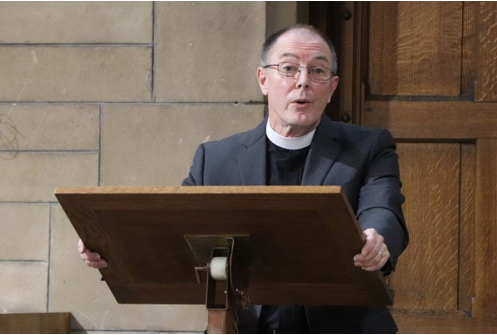Veiling in Passiontide


The Reverend Dr Michael Hull writes:
It is customary to veil crucifixes, statues and images in churches during Passiontide. Passiontide is the final fortnight of Lent. It begins on Passion Sunday (the fifth Sunday in Lent) and runs through Palm Sunday (the sixth Sunday in Lent) and Holy Week to Easter Day. Veils may be purple, red or black: the colour is inconsequential. It is the symbolism of the veiling that counts. As Jesus begins his sorrowful way to the Cross, he no longer walks openly among us. His glory is hushed, and his divinity is hidden during his suffering and death. The Sacrifice on the Cross, the means of our redemption, lays obscured as do the statues and images of the saints for Passiontide, for if the Master is veiled so too are his servants.
The traditional Gospel passage for Passion Sunday is John 8.46–59. In that pericope, Jesus explains to some of his fellow Jews in Jerusalem that God, his Father, will glorify him. Dismayed at their incredulity, Jesus assures them of two things: first, his own pre-existence, ‘before Abraham came to be I AM’; and, second, the gift of eternal life for those who believe in him. ‘Then took they up stones to cast at him: but Jesus hid himself, and went out of the temple, going through the midst of them, and so passed by’ (v. 59). On the one hand, Jesus is hidden from them insofar as they are unable to kill him physically for his hour had not yet come. A similar event had occurred earlier in Jesus’s hometown of Nazareth (Luke 4.1–30). There Jesus announced his messiahship using the language of Isaiah to the effect that the Spirit of the Lord was upon him. The Nazarenes reaction was similar. They intended to throw Jesus off the brow of a hill, but ‘passing through the midst of them [he] went his way’ (Luke 4.30). On the other hand, Jesus is hidden from them spiritually insofar as they are unable to see, that is, to recognise him as their Messiah. Instead, they take Jesus to be a blasphemer.
Passiontide recalls the spiritual blindness of our forebears who beat the Messiah and hanged him on a tree (Acts 5.30) not to point fingers at them, nor to merely recount historical occurrences, but to remind us of our own spiritual blindness. There is a ritual, now it seems seldom practised, where the veiling of the crucifixes, statues and images occurs during the Communion Office as the last verse of Passion Sunday’s gospel is read. As the priest finishes reading, ‘but Jesus hid himself, and went out of the temple, going through the midst of them, and so passed by’, the people rise from their pews and hang the veils in silence. That sort of ritual veil-hanging is, to my mind, stunningly beautiful and insightful. It symbolises our inability to recognise Jesus the Messiah because of our sin and indifference. It is, to be sure, counterintuitive. We conceal in order to reveal. We dim our vision in order to sharpen it. Our goal? To see the Messiah! We do not want him to pass us by.
Passiontide is the crescendo that brings us to the foot of the Cross and leaves us waiting at the Sepulchre. Passiontide is the last call to focus on the Messiah. Passiontide is the time to look for the Messiah so earnestly as to ignore almost everything else. As Scottish Episcopalians we do that liturgically. The liturgies of Passiontide, particularly the readings from Holy Scripture assigned to them, are poignant. I am taken with one optional prayer for Passiontide in our Scottish Prayer Book: ‘Grant unto us that, rightly observing this holy season, we may learn to know thee better, to love thee more, and to serve thee with a perfect will’ (p. 146).
To rightly observe Passiontide is to seek the veiled Messiah whose glory is hushed and whose divinity is hidden for a wee while. The fruits of Jesus’s Passion ensure that his glory and divinity cannot be hushed or hidden for long. Jesus himself says so as he triumphantly enters Jerusalem when some Pharisees ask him to rebuke his disciples. ‘I tell you that, if these should hold their peace, the stones would immediately cry out’ (Luke 19.40).
We shall cry out on Easter Day ‘Alleluia, Alleluia, Alleluia!’ Just as we have hung the veils, so too we shall take them down, not unlike the way in which St Matthew recalls the veil of the temple being rent in twain from the top to the bottom (27.51). Passiontide will give way to Eastertide wherein our goal will be realised: the veil will be lifted, and we will see the Messiah!

The Reverend Dr Michael Hull has been an Assistant Priest at St Vincent’s since 2015. He is also Director of Studies for the Scottish Episcopal Institute, and will shortly be its Principal.
